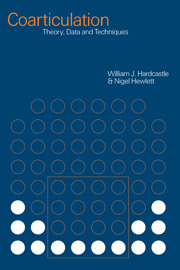Book contents
- Frontmatter
- Contents
- List of figures
- List of tables
- List of contributors
- Acknowledgments
- Introduction
- Part I Theories and models
- Part II Research results: components of the motor system for speech
- 3 Velopharyngeal coarticulation
- 4 Lingual coarticulation
- 5 Laryngeal coarticulation
- 6 Labial coarticulation
- 7 Lip and jaw coarticulation
- Part III Wider perspectives
- Part IV Instrumental techniques
- References
- Index
4 - Lingual coarticulation
Published online by Cambridge University Press: 22 September 2009
- Frontmatter
- Contents
- List of figures
- List of tables
- List of contributors
- Acknowledgments
- Introduction
- Part I Theories and models
- Part II Research results: components of the motor system for speech
- 3 Velopharyngeal coarticulation
- 4 Lingual coarticulation
- 5 Laryngeal coarticulation
- 6 Labial coarticulation
- 7 Lip and jaw coarticulation
- Part III Wider perspectives
- Part IV Instrumental techniques
- References
- Index
Summary
Introduction
The review of lingual coarticulation presented here is organized with reference to different vowel and consonant gestures. A rationale for this methodological approach is that a specific lingual region may exhibit different coarticulatory behaviours depending on its involvement in gestural production. Thus, for example, the tongue blade should be more resistant to coarticulatory effects during the production of dentoalveolar consonants than of velar consonants since it participates actively in the formation of a dentoalveolar closure or constriction. Coarticulatory sensitivity for a given lingual region will be shown to depend not only on place and manner of articulation requirements but also on mechanical restrictions such as flexibility and coupling with other lingual regions.
A goal of this study is to approach the problem of articulatory control in speech production. Our hypothesis is that the degree of coarticulatory variability exhibited by a given tongue region is in many respects indicative of the degree of control exerted upon it by the speaker: thus, an increase in articulatory control should cause a decrease in coarticulatory sensitivity. It seems that in some cases we must neutralize the influence of possible mechanical constraints in order to draw significant inferences about articulatory control; thus, a given tongue region may be resistant to coarticulatory effects just because it happens to be coupled with a primary articulator (e.g. the tongue predorsum during the production of laminal stops).
- Type
- Chapter
- Information
- CoarticulationTheory, Data and Techniques, pp. 80 - 104Publisher: Cambridge University PressPrint publication year: 1999
- 27
- Cited by

